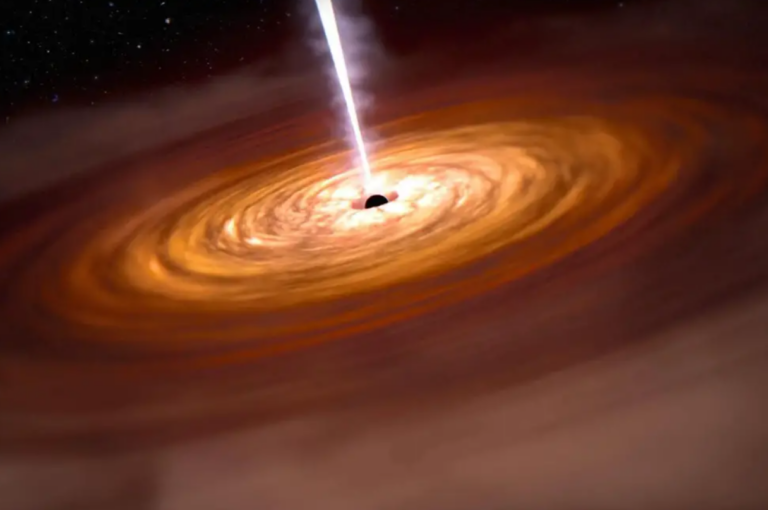Astronomers discover the universe’s brightest object, shining 500 trillion times brighter than the Sun
How big is the Universe? It’s so big, there is an object 500 trillion times as bright as the Sun, and the skies are still dark at night.
Scientists have identified what is now the largest quasar, which is 12 billion light-years away from Earth, which is fed by a black hole, gobbles up an equivalent of sun mass per day. This quasar which radiates 500 trillion times the intensity of the sun was first believed to be a star because of its brightness. The accretion disc of the quasar (which locates approximately 12 billion light years away from the earth) is approximately 15,000 times the size of the distance between the sun and the Neptun and is considered one of the biggest structures in the universe. Even after its brightness was tens of billions of times that of our galaxy, it had remained invisible until recently indicating that similar objects might be lurking undetected in the universe and that other such objects might similarly escape conventional detection techniques.
Scientists have discovered the brightest known object in the universe, namely a quasar that is the luminous core of a galaxy which is 12 billion light years away.
Quasars are the brightest objects in the universe for they are powered by supermassive black holes that actively accrete surrounding disks of gas and dust. The black hole at the core of this specific quasar is consuming more than one sun’s mass daily, which makes it the fastest-growing black hole ever recorded, the ESA notes.
It has an extent of about seven light-years and outshines our Sun: it has a luminosity five hundred trillion times that of our Sun, according to the scientists in Nature Astronomy.
Describing this quasar, Christian Wolf who is the lead author of the study, and an astrophysical at the Australian National University told the Associated Press’s Marcia Dunn, “This quasar is the most violent place we know of in the universe”.
“It is a wonder it has remained undetected until now, given that we had previously identified and listed a million or so less spectacular quasars,” adds Christopher Onken from the Australian National University, who is also a co-author of the study. “For it to be hiding somewhere, it has been in plain sight all this time. ”
Quasars each contain a supermassive black hole which feeds on stars and gas clouds from an orbiting structure known as the accretion disc. The discs material rubs against itself and produces a great amount of heat that can be felt light-years away.
In 1980 the phantom with the designation J059-4351 was obtained by the Schmidt Southern Sky Survey telescope located in Australia, however it was mistaken for a star supposedly being a regular quasar. Normally astronomers employ some kind of machine learning algorithm to look for quasars by using large sections of the sky and looking for objects similar to quasars. However, this makes it harder to detect outliers in the quasars’ luminosity distribution, such as the quasars not conforming to the so-called ‘stripping’ pattern.
In a follow-up carried out last year, the researchers established that the object was, in effect, a quasar using a telescope at the Siding Spring Observatory in Australia. In the same year they supplemented it with results obtained from the Very Large Telescope in Chile that certified it as the brightest quasar ever observed.
Priyamvada Natarajan, an astrophysicist at Yale University, who did not participate in the study said in a statement to the AP, “The exciting part about this quasar is that it was hiding in plain sight and had been previously misclassified as a star. ”
The distance of the accretion disc around the quasar is about 15000 times the distance between the sun and the planet Neptune the mean mass of the black hole is around 17 billion suns says the ESA.
The black hole in the quasar is greedy, gulping in material at a rate of 413 suns per year according to New Scientist’s Wilkins. Thus, the disc emits a huge amount of energy, and disc becomes very bright.
Wolf describes to Tory Shepherd of the Guardian that it look like a super magnetic storm cell with temperatures at 10,000 degree Celsius with flashes or lightning all over and wind of such speed that could encircle the globe within a second.
Future researchers might more precisely determine the mass of the central black hole, though the size of the accretion disc means that this is likely still possible, according to Christine Done of Durham University in England, who did not participate in the research, in an interview with New Scientist.
“This quasar is so large and bright that we could sort of see it with the present-day instruments,” Done says to the publication. The good thing that we can do this much more precisely in this monster is that we can thus get a much more precise measure of the black hole’s mass. ”
It is estimated that the light coming from the quasar has traversed 95% of the age of the universe to get to us by now taking approximately 12 billion years. Its black hole presumably ceased to accrete from external sources long ago due to the fact that most of the gas that once used to be diffuse and move freely across the stellar environment to fall into a black hole has already formed the stars orbiting black holes on grand spiral parabolic orbits. Therefore the formation of these giant objects has not been nearly as active as they were in the earlier years of the universe.
Do not forget to share your opinion with us to provide you with the best posts !




0 Comments